Do you need to develop software but do not know what methodology would suit your requirements best? Agile software development is a result-oriented way of building products from scratch that helps to consider all their weak spots and improve them on the go. As a result, you get a valuable product that no one can compete with. Isn’t this what everyone is looking for?
If we speak statistically, 71% of companies in the US are already using Agile.
What is more, projects made based on this methodology have a 64% success rate. Whereas projects made using other practices (like Waterfall) have less than a 49% success rate.
This means that Agile projects are 1.5x more successful.
In this article, we will dive deep into what Agile is, its pros and cons, as well as its basic elements and values. Read more to find out about all these and many more.
Today, Agile is not a single framework, it is a collection of working practices and frameworks united under common values and principles of the Manifesto. Unlike traditional ones, Agile frameworks aren’t linear, slow, and predictable. Instead, they are very dynamic and adaptable to the company and market.
Many people think that by implementing this method, you get a sure-proof way of solving any issue (of course, it is not true) but, in reality, you create a collaborative environment and culture where solutions emerge.
Most Agile gurus suggest opting for Agile if you already have clearly defined business objectives, necessary teams, and technologies. However, for most companies, the biggest challenge would be to find the right balance between having cross-functional teams, integration, and collaborative principles and standards. And the best way is to start with a simple project and experiment. This way, you will be able to build and scale up your tech capabilities.
What is Agile?
Yes, everyone talks about it, but do you really know how it works?
First of all, in English, agile or agility means being able to quickly respond to some changes in an uncertain and even turbulent environment.
The creators of Agile Manifesto, which is a groundwork on Agile methodology, chose this word because it represents flexible adaptiveness and response to changes. It is about how you understand what’s going on, find the issues you are facing, and are able to adapt and adjust to the changes.
Let’s have a brief look at the history of this methodology.
The History of Agile
We can divide the history of Agile into three periods: pre-2001 when people started using some of the agile principles through their experience, 2001 when the Agile Manifesto was created, and post-2001 when agile methodology started developing and gaining new shades.
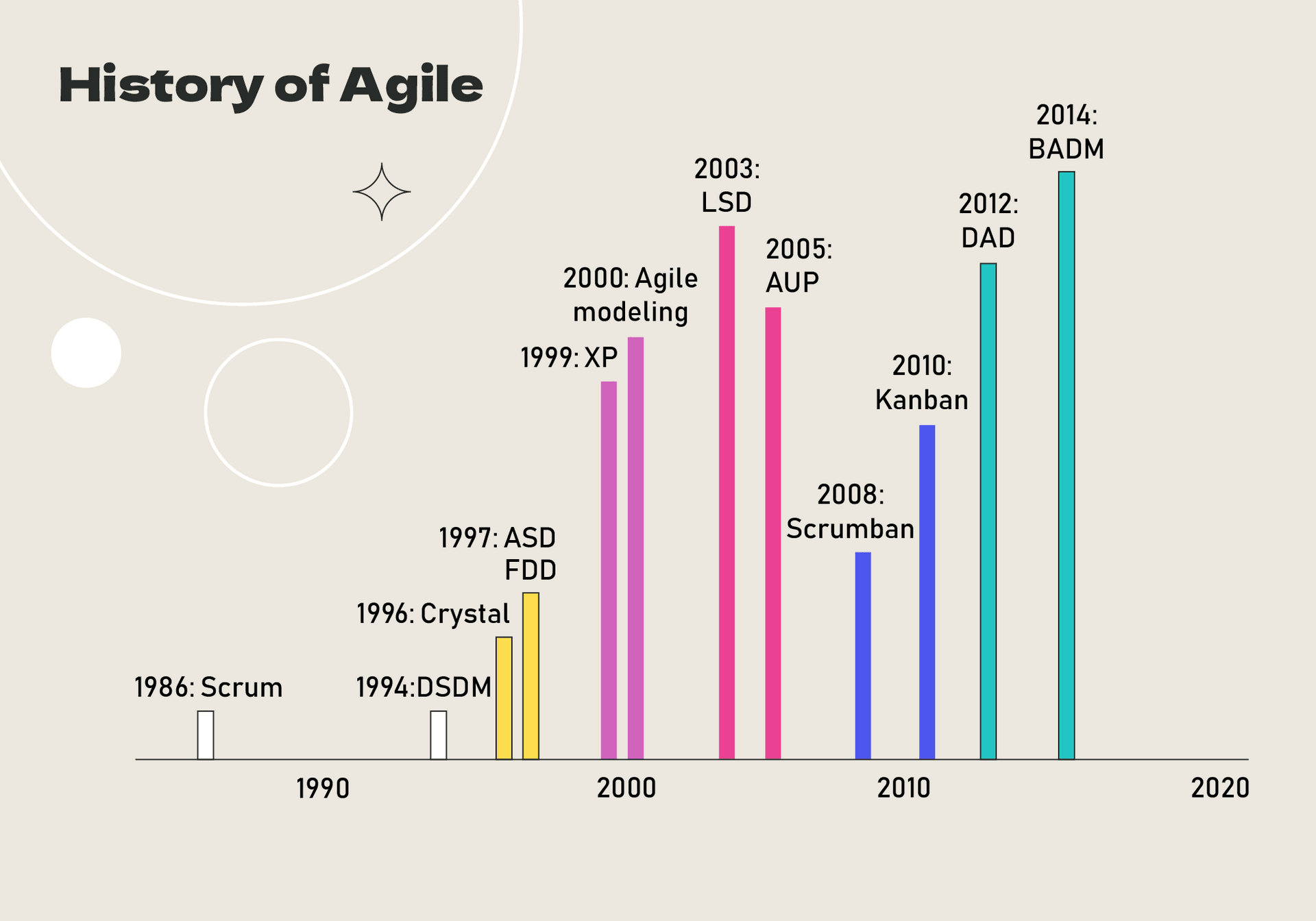
Here is a brief overview of each of the stages:
Pre-2001:
Even before the appearance of the manifesto, software developers and consultants tried mixing old and new ideas in order to create a better and working version of how software should be built. This version included close cooperation between developers and stakeholders, self-organized development teams, and new smart ways to create and deliver code.
They also created working frameworks of how everything should be organized that later were coined into such well-known practices as Scrum, Dynamic Systems Development (DSDM), Feature Driven Development (FDD), Extreme Programming (brainchild of Kent Beck), and many others. As a result, people tried to adapt these techniques by adding necessary elements that would work in their cases.
2001:
This year is marked with the appearance of the Agile Manifesto. 17 people (including Martin Fowler, Jon Kern, Jim Highsmith, Ken Schwaber, Bob Martin, and others) met at the ski resort in Snowbird, Utah, and created Manifesto for Agile Software Development. Basically, it consists of agile values that are the foundation of Agile software development and 12 principles behind this methodology.
Post-2001:
After the Manifesto was ready, its authors published it on their website AgileManifesto.org. A bit later, they also created the so-called Agile Alliance, which became a union where developers shared their knowledge and ideas on software creation.
Since then, many companies and developers have started employing agile methodology in their work. And later, the community of software developers who used Agile methodology expanded with other people who work with them on consulting, tools, frameworks, and training.
Agile practice went global and many started adding their own ideas and practices to the already existing Manifesto. Soon, Agile got a new meaning and became a way people do their work, instead of just being just a software development method.
What is Agile Software Development?
Today, Agile software development goes far beyond famous frameworks like Scrum or Extreme Programming, and beyond its common practices like stand-ups, sprints, or test-driven development. It is now transformed into an umbrella term for multiple frameworks and practices that are united and based on the principles and values stated in the Manifesto.
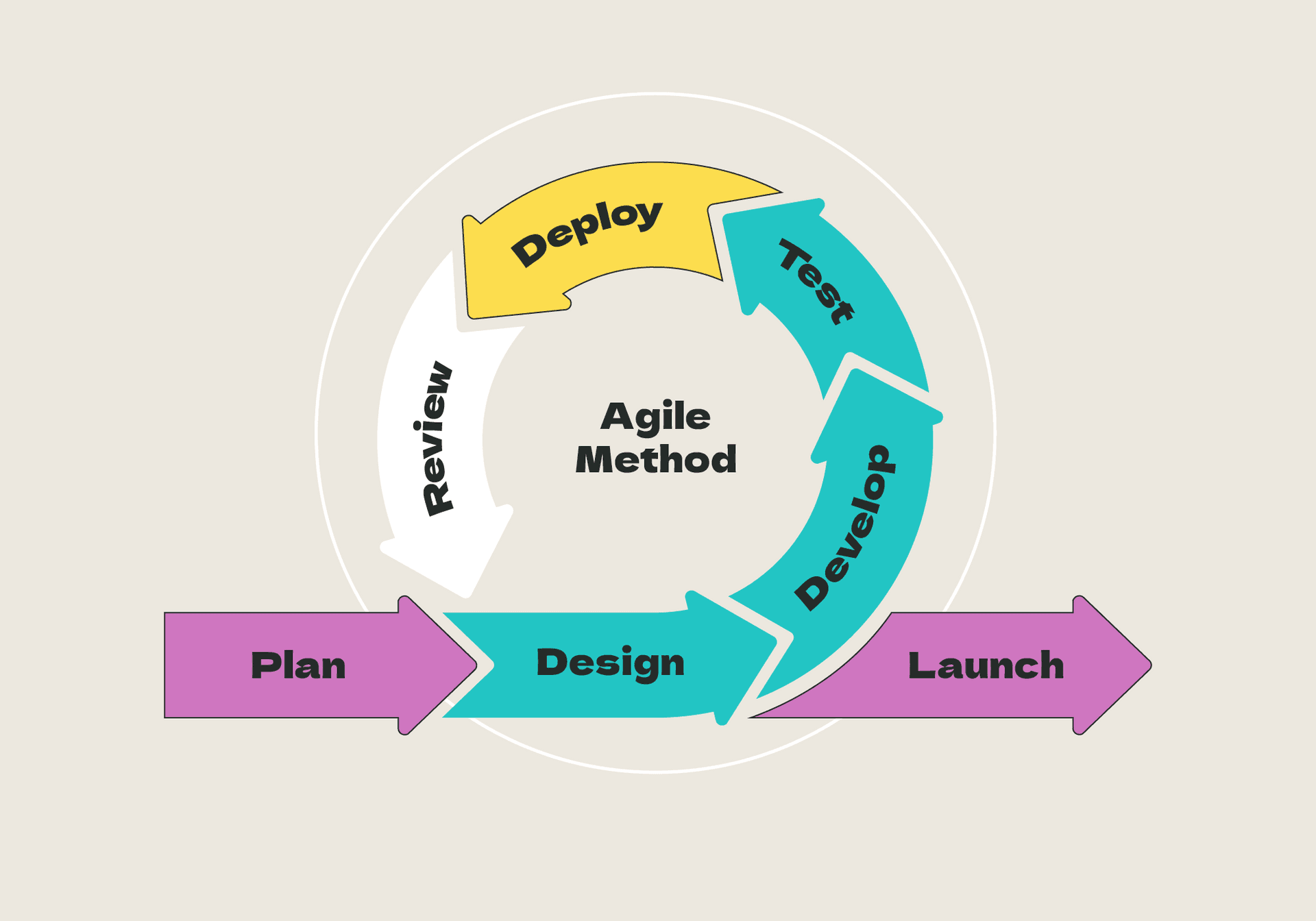
Why choose Agile software development then?
The thing is that when you deal with software development, it is extremely helpful to be geared by common values and practices. They help you to act correctly in a particular context. The key thing that differentiates agile software development from many others is its focus on people working together and the ways they cooperate. All the products created using the agile method are made in collaboration with self-organized, and, what is more important, cross-functional teams who use the right practices.
Agile Software Development Values
Now that you get acquainted with agile software development, let’s find out its four key values as stated in its Manifesto.
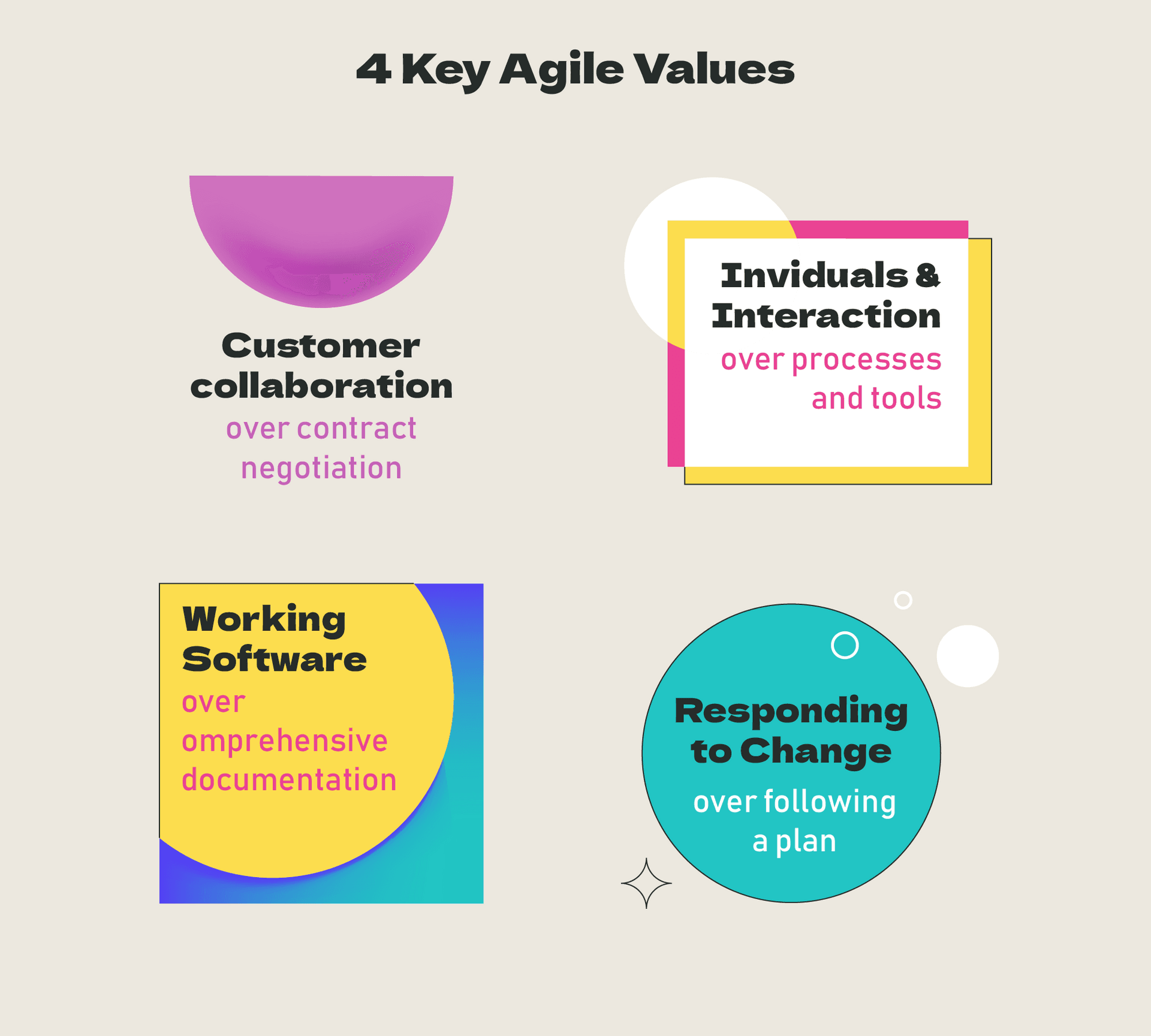
-
People and interactions
Many companies and development teams, in particular, focus on having the latest technologies and tools onboard. Yes, that is great, but it is only halfway to success. More important than the tech stack are the people who work behind it.
That is why having the right team of experts is priceless, as even the best tools won’t work magic in the wrong hands. How people interact and communicate in the team is very important, too, as this helps to better collaborate and solve issues more effectively .
-
Software
Creating thorough documentation before starting the development process is great. But sometimes it takes too much time that you can spend more effectively on writing code. So, while documentation is not a bad thing, you should make software development your priority. And then, you can collect the feedback and make changes if necessary.
-
Interaction with customers
Do you remember the time when customers added even the smallest detail they want to see in their finished product to the contract? How did they act when they found a contrast between what was stated in the contract and the finished product? Yes, they got frustrated.
According to the Manifesto, you should opt for a continuous development process. What does this mean? It means that you communicate with your customer through the whole development process, receive feedback, and adapt the product so that it better fits their requirements.
-
Flexible roadmap
We live in an always-changing world where even the roadmap for software development can’t be static. The requirements and priorities might change with the course of the actions. So, your software development team needs to be agile and adapt to the changes. This becomes possible with a dynamic roadmap that changes regularly.
The 12 Principles of Agile
So, we went through values, but what are those twelve principles stated in the Manifesto? To put it briefly, they all add to the agile culture, where changes are inevitable and the main priority and focus is the customer. 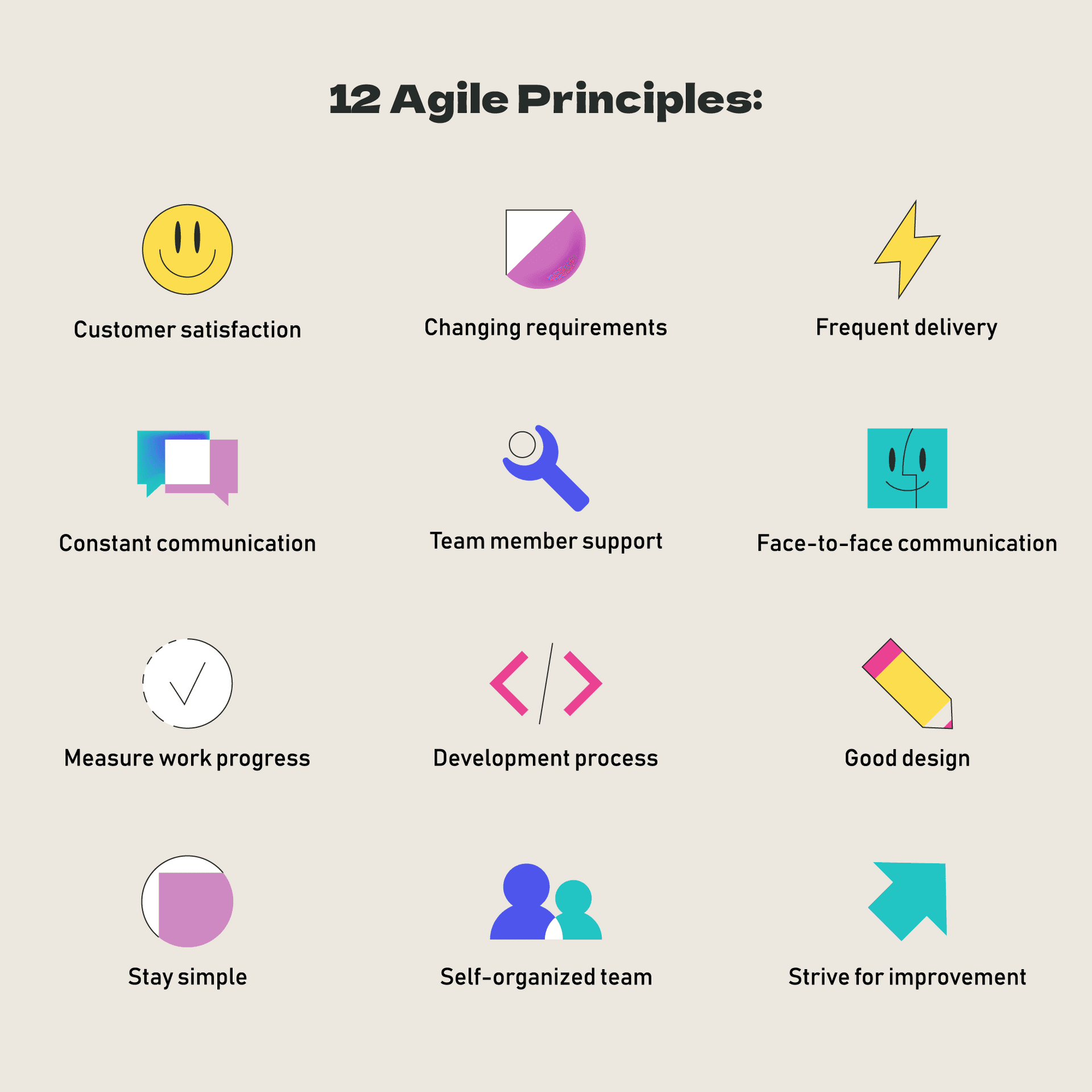
- It is better to meet customers’ requirements by conducting continuous software delivery. This means that customers feel happier when they receive working software at some short and regular intervals than wait long periods of time for the iteration between multiple releases.
-
You need to adjust to changing requirements throughout the whole development process so that there won’t be long delays when change is requested.
-
Focus on regular delivery of working software. This has become possible thanks to Scrum and sprints that ensure the frequent delivery of working software.
-
Business stakeholders must collaborate closely with developers during the whole development project. This way, you are able to make better decisions and the working process runs smoothly.
-
You need to constantly support, motivate, and trust your team, as an unhappy team won’t deliver great results and this may result in a burndown.
-
Opt for face-to-face communication if possible, as such type of interaction is more successful.
-
Your key measure of progress and the ultimate goal should always be working software.
-
Employ agile processes and repeatable and maintainable delivery speed for your team so that they can build working software with each of the releases.
-
Be careful about tech aspects and design to stay agile. These two elements ensure that your team keeps up with the pace, is able to improve your product, and can make changes.
-
Simplicity is the key to everything. Do not go beyond what is expected from you, build enough so that your job is done for now.
-
Self-organized teams are a must. Such motivated teams can take ownership, make decisions autonomously, and share their own ideas to deliver better results.
-
Always strive for improvement as improving your skills, processes, or techniques helps make your work more effective.
The key focus of Agile software development is to stay in line with these principles to deliver success. All the projects based on Agile are customer-focused and encourage the active participation of customers in the development process.
How to Implement Agile Development
If you consider implementing Agile methodology for your project or the whole company, here are the five necessary steps that will help you out:
-
Get everyone on board: according to Agile methodology, successful work and Agile adoption mean collaboration between all the involved, including your customer, project and development team, and your stakeholder. So, you need first to explain to everyone what benefits Agile will bring, as well as answer all their questions and address concerns.
-
Don’t go the extra mile: it’s better to start with one small project and receive feedback. And only then start applying Agile to other projects.
-
Constantly motivate and empower your team: Agile methodology fully relies on team communication, collaboration, and problem-solving. This means if your team is not motivated, the chances for successful adoption are very low.
-
Adopt a framework and follow it: Agile methodology completely changes the way you work. That is why you need to choose the Agile framework that works for you and stick to it.
-
Hold a retrospective: when you are just implementing Agile methodology, you should not adapt and make changes to the existing frameworks while your team is still learning how to work. Instead, you should regularly check what is working for you and make improvements. Or if it doesn't work, consider employing another framework. You should also discuss with your team your future moves.
-
Get necessary tools onboard: typically, teams who choose Agile employ tools like Jira, Digital.ai, or Azure DevOps for collaboration and such Agile features like Kanban board or backlog. They help to prioritize tasks, receive feedback, finish user stories, and automate workflow.
Common Agile Software Development Pitfalls
Here, we have collected a list of the most common pitfalls you may face when first implementing Agile methodology in your business processes.
-
Not involving stakeholders in the education process
Yep, you have taught your development team the nuances of Agile methodology, but what about the key leadership or your customers? If you haven’t taught them yet, then it is most likely that they will continue using traditional practices and not align with your team. That is why you must ensure that your team and stakeholders partner and stay aligned to remove any corporate barriers and succeed.
-
Not educating all members of your core development team
Just like in real life, there might be engineers who will continue using an old-fashioned methodology (like writing documentation and only then coding). So, your goal is to make them believe that the Agile approach is better by playing off early success.
-
Having fear of failure
If you fail our sprint, it doesn’t mean that the world is over. On the contrary, it should give you clarity on what needs improvement and teach you a lesson. Of course, mostly in the corporate culture, failures tend to be hidden. However, you should act oppositely and involve transparency for all the team members.
-
Thinking that Agile is a synonym for fast
Don’t think that being agile means faster processes. Of course, it’s its aspect, but Agile focuses on the clarity of the received outcomes and avoidance of wasted time, energy, and resources. Short cycles of the Agile method do allow you to get benefits more efficiently, but not always faster.
Measuring Agility
So, are there any metrics on how to measure the agility of your organization? Below, we have listed some of the metrics that can present you with information on how to improve and make better decisions.

-
Cycle time or speed of the process
To put it simply, cycle time is the time needed for a company to deliver outcomes. To calculate it, you need to know the time from the beginning till the end of your work. By calculating this metric and looking at the cycle time of similar activities, you can find out how fast your team can finish a certain task. If the cycle time increases, it means that your team may face some internal issues that you need to fix. And to decrease this metric, you could try decreasing work in progress.
-
Process effectiveness
This is probably the most crucial metric that defines whether you need to optimize your resources without the need to invest more. You can calculate it by defining the ratio between the time the tasks wait in queues and the time they are worked on. This way, you can get the average effectiveness of a certain type of task. When you find out your weak spot, you can improve it by bettering communication between different departments, or limiting the number of reviews, handoffs, or time waiting on dependency. Usually, the average process effectiveness is 50%.
-
Velocity
Velocity is the amount of work a team completes in a sprint that is determined by story points. This metric is vital for finding out the scope of work and value your team can produce in a sprint and also when estimating the team’s capacity during planning.
-
The happiness of your team and stakeholders
Having excellent quantitative data is great, but if your team feels unhappy, they won’t stay with you for very long. To work like clockwork, you must make sure that each team member together with stakeholders feels happy about what is going on. And yes, happiness is a metric, because unhappy workers won’t deliver great results.
-
Throughput
Basically, throughput determines how many tasks are completed over a certain period of time. This indicator shows you the level of the team’s productivity. If you see bouncing of the throughput up and down, it means that there might be some workflow issues.
Roles in Agile Methodology
The main aim of Agile is to create holistic teams that have cross-functional knowledge. So, what are the typical key roles that you can find in the Agile methodology?
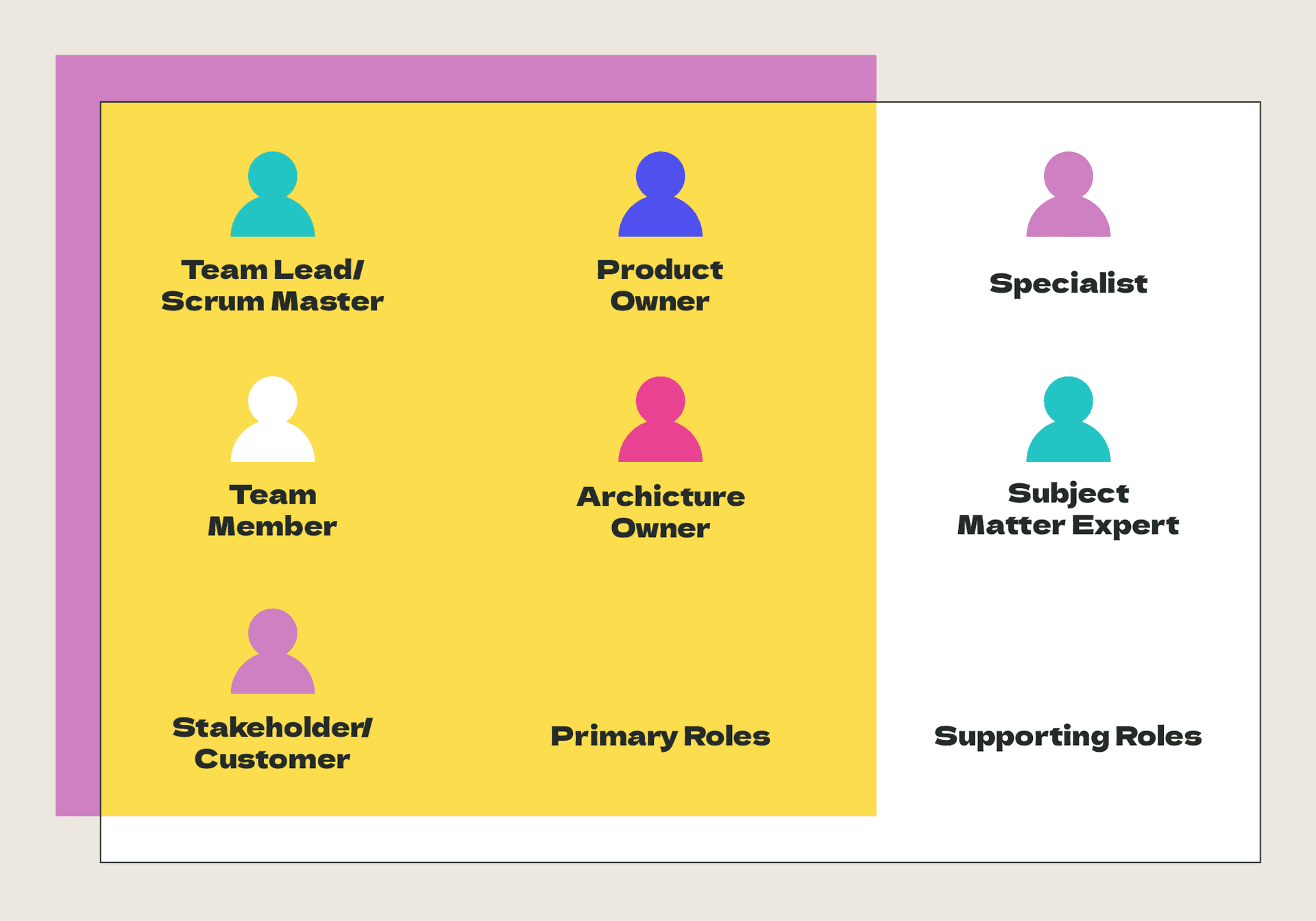
-
Product Owner: product owner is oftentimes the stakeholder of the whole project who is responsible for project progress and setting up directions. The main requirement for this role is understanding the needs of the project from the perspective of the stakeholder and communicating them to the whole product development team. Plus, the Product Owner knows all the long-term business goals and ensures that the project stays in line with these needs.
Among the key responsibilities for this role are management of the stakeholder, release, and Scrum backlog. Thus, the Product Owner manages backlog items, sets priorities based on the stakeholder feedback and circumstances, releases cycle planning, and makes sure that the whole product development process transforms into value for all the stakeholders.
-
Team Lead or Scrum Master: this role’s responsibilities include team coordination, taking instructions from the Product Owner and ensuring that they are performed correctly, and ensuring effective Scrum implementation. Besides, Scrum Master is in charge of conducting Scrum and Sprint initiatives, communicating between different team members, training staff, and working on administrative tasks such as facilitating collaboration and conducting regular meetings.
-
Development team: this is a team of specialists that work on product development with cross-functional skills necessary to turn ideas into products. Among the common skills required for a dev team are:
-
Technical writer
-
Product designer
-
UX designer
-
Developer
-
QA specialist
-
Among the key responsibilities of the development team is to work on sprints provided by the Product Owner and then coordinated by a Scrum Master and take part in the Daily Scrum standup meetings where the project progress is discussed.
-
Stakeholders: this is the role that influences all the decisions and work of the whole Scrum team. Who can be a stakeholder? The end user, investor, business executive, external auditors, or production support staff can represent a stakeholder. The main stakeholders' responsibilities are to direct the progress of the whole project so that it meets both business goals and customer’s expectations.
-
Additional roles: if the project is complex, it may include some extra roles such as:
-
A tech and domain expert who specializes in technologies and understands stakeholder’s requirements
-
Testing and audit team who works independently and joins the Scrum team to help during the product development stage
-
Integrator for work with the integration of the subsystems of the project and testing conducted by external QA teams
-
Architect Owner who works with architecture (its envisioning, planning, and decision-making process)
-
Advantages and Disadvantages of Agile
Now let’s have a look at both the advantages and disadvantages of the Agile methodology:
Pros:
- By implementing Agile methodology, you get continuous delivery of software.
- Customers collaborate with you and they can see the working features that meet their requirements.
- If customers want to make changes, you can do them on the go and add them to the current release of the product.
- You get much happier customers because they get a working feature after each Sprint is finished.
- You get daily meaningful interaction between all the team members and stakeholders.
- Thanks to Agile, you get an excellent and user-friendly design of the product as it is one of its main concerns.
- The development process is flexible, meaning you can add changes and new requirements even during the late stages of the development.
- Agile methodology, and direct collaboration, in particular, can destroy any corporate barriers and create a spirit of support, trust, acceptance, and partnership.
Cons:
- You will get less documentation if you opt for this method.
- Some projects may be quite difficult to estimate at the early stage of their development.
- It can be quite tricky as, with the possibility to evolve lots of features, your project may last forever.
- If you have a complex project, the accurate estimation of the needed effort and resources for its completion might be tricky.
- Oftentimes, the requirements are quite vague and not clear, so you can’t predict the end result.
Key Takeaways
Can you imagine that Agile methodology has already turned 20 years old? A methodology that started as just some easy collaboration method for startups with whiteboards and stickers has transformed into a smart, reliable, and popular development process worldwide.
Today, Agile is not a single framework, it is a collection of working practices and frameworks united under common values and principles of the Manifesto. Unlike traditional ones, Agile frameworks aren’t linear, slow, and predictable. Instead, they are very dynamic and adaptable to the company and market.
Many people think that by implementing this method, you get a sure-proof way of solving any issue (of course, it is not true) but, in reality, you create a collaborative environment and culture where solutions emerge.
Most Agile gurus suggest opting for Agile if you already have clearly defined business objectives, necessary teams, and technologies. However, for most companies, the biggest challenge would be to find the right balance between having cross-functional teams, integration, and collaborative principles and standards. And the best way is to start with a simple project and experiment. This way, you will be able to build and scale up your tech capabilities.